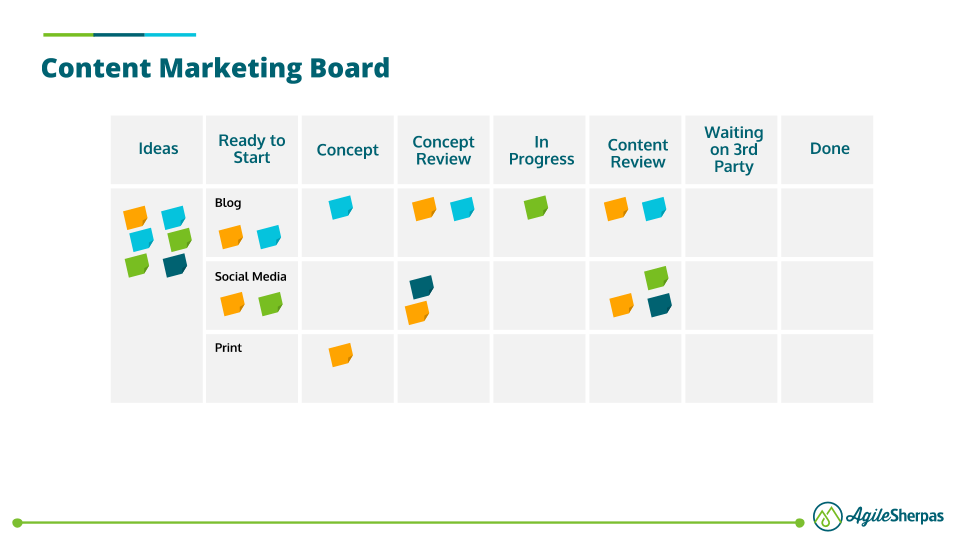Improve your Marketing Ops every week
Subscribe to our blog to get insights sent directly to your inbox.
Confront your process problems head on with a Sherpa by your side.
Explore support options that are tailored to meet you wherever you are on your climb.
Browse our pioneering Agile marketing courses
Learn from the stories of marketers already on the road to process improvement.
Featured Resource

State of Agile Marketing
Learn from 8 years of study on how marketers are increasing their agility.
Download Report
Marketers as a group have a lot in common.
Whether we're selling to other businesses or directly to individual consumers, we're tasked with building customer relationships, maintaining brand identity, and appealing to decision makers.
But despite this shared foundation, business-to-business (B2B) and business-to-consumer (B2C) marketing each comes with its own set of challenges.
B2C marketers tend to emphasize volume and novelty, while their B2B colleagues focus more on campaigns that deliver predictability and reliability. This quest to build customer trust through consistent delivery of value seems to be one of the reasons that B2B marketers are turning to Agile ways of working in droves.
In fact, the Annual State of Agile Marketing Report concluded that 52% of the marketing teams that rely on Agile frameworks to manage their process were part of B2B organizations, while only 12% of marketers using Agile labeled themselves as marketing directly to consumers.
If you're a B2B marketer wondering how to make Agile marketing work for you, you've come to right place. In this article we'll look at the most common Agile practices for B2B marketers so you too can use Agile ways of working to master the complexities of B2B buyers' journeys.
B2B marketers working in an Agile way plan iteratively in order to keep up with their decision-makers as their demands and business needs change.
Traditionally, marketers plan their outputs for a long period of time ahead, sometimes as far as five years in advance, in as much detail as possible. The plan often comes in the form of an elaborate annual roadmap complete with dates, requirements, and charts.
It also takes forever to be prepared and socialized within the marketing department.
Although creating it makes us feel productive and safe that we've got a handle on our departmental future, chances are the plan will be outdated before the first campaign hits market.
Instead of wasting weeks in planning outputs with questionable value months down the line, B2B marketers who apply Agile focus more on the desired outcomes. This allows them to determine a destination for the scope of the plan without spending too much of their productive time laying out every activity or campaign they want to deliver within that period of time.

An Agile plan contains a finite set of guiding objectives, to which the team refers as they tackle new work. This enables them to spend less time planning and more time actually working on achieving the marketing goals they’ve set.
As circumstances around them change, they have the flexibility to adjust their methods for hitting the targets they've set. This doesn’t require spending days rewriting a complex document approved by leadership. Instead, it asks the team to take the new reality into account in their next iteration of planning marketing work.
Organizational structure is a major influencer on team behavior. It can either facilitate higher productivity or set barriers that prevent us from achieving it.
In centralized leadership structures, functional teams of experts in the same area may form teams with a highly controlled flow of information, called silos.
Over time, this traditional team structure has become regarded as a major productivity killer, slowing down the flow of value across the whole marketing value stream.
Whether functional silos inside our organizations are still valuable in some cases is a topic of debate, but what has been proven are the unparalleled benefits of adopting cross-functionality.
Cross-functionality enables us to build teams in a way that combines contributors with all the various skills necessary to complete marketing campaigns in order to minimize the dependencies outside the core team.
When team members have the ability to work on different parts of the team’s projects, they are able to improve several key productivity aspects of the B2B marketing process:
Skill diversity reduces the need for handover and waiting on third parties or other functional teams to help. This allows predictability within the team to improve and the pace of work to become more sustainable.
With better communication and sharing of work, tasks can be distributed more equitably, keeping everyone working at a reasonable clip that they can sustain indefinitely.
If team members can work together on a variety of projects, they become a more collaborative contributor who can participate in more frequent releases of marketing collateral.
Last but not least, cross-functionality enables us to communicate about what’s really important, what can be reused, and what just doesn’t work, so we can eliminate low-value projects from the team’s docket.
These four benefits are especially important for B2B marketing teams because their success hinges on supporting their customers through a longer journey than that of a B2C marketer. With large deal sizes and a lengthy procurement process, marketing to business customers requires more consistent nurturing and building trust upfront before a conversion can occur.
Most B2B marketers are likely used to work items getting assigned via email or face-to-face conversation. In turn, these ad hoc requests turn into infinite individual to-do lists that no one in the team (other than the assignee, of course) has visibility into.
B2B Agile marketing teams swear by visual management. Adopting Kanban boards has become the favorite method of visual task management for teams looking for an antidote to lack of process transparency.

A Kanban board visualizes the process steps it takes to turn a marketing request into a deliverable asset. Work items flow through the board, from marketing backlog, through in progress phases, and, finally, to completion.
The basic Kanban board consists of three stages:
They are visualized as vertical columns and the granular tasks that comprise our projects are listed as tickets on the board based on their state.
When an Agile team builds the habit of visualizing their work this way, they can proceed to evolve the board to reflect all the steps that make up the process, like “Ready for Review”, “Review in Progress”, and “Waiting on 3rd Party'”.
This visualization is invaluable for creating shared understanding about the workload of the whole team and showcasing where the B2B marketing process could use improvement.
With its help, B2B marketers can spot problems at an early stage and take action to resolve them before they affect the predictability of their process negatively.
Multitasking helps us get more done, right?
Many believe that to be true and we can still see “the ability to work on multiple tasks at once” as a role requirement on many marketing job ads.
In reality, multitasking is among the biggest productivity killers that reduce the effectiveness and efficiency of any B2B marketing process. Unlike multiple core computer processors, our brains are not wired to operate on several different fronts at the same time. Switching between different tasks requires time and mental power that is better spent on productive work.
When we’ve got a whole team of people doing it, the negative effect of context-switching scales tenfold.
Multitasking results in delivering value with sub-optimal quality and creates the impression that we are slow to complete work because we often drop in progress work items to attend to a new request.
This can be extremely damaging to B2B marketing teams with high stakes campaigns in the pipeline and many internal stakeholders at the door with new asks. B2B marketers need to protect their focus by ruthlessly prioritizing where they spend their time or risk slowing down a campaign launch and disappointing customers.
That is why, instead of succumbing to this common process challenge, B2B Agile teams limit the amount of work they process simultaneously.
Work in progress (WIP) limits allow Agile teams to define limits around how much work is in progress at once. To avoid juggling between too many work items, contributors are encouraged to complete something before they can start something else.
Teams can limit work in progress per person (ex. 2-3 tasks in progress per person) or on a team level per process stage (ex. 3-4 tasks in the column at a time for the whole team).
In addition to reducing the time started work items remain idle, limiting work in progress allows us to identify the stages of the marketing process where work gets stuck and resolve the blockage before it derails the whole workflow.
Traditional marketers have the tendency to focus their attention solely on measuring impact KPIs (e.g. attracted website visitors, new leads per week, etc.). Such metrics are foundational to determine if we are doing a good job or we need to rethink our methods.

However, they tell us a lot about WHAT we’ve delivered, yet very little about HOW we’re making it happen.
It’s true that you can’t improve what you don’t measure, so B2B Agile teams measure process metrics in addition to measuring campaign performance to improve their process equally with their deliverables.
Process metrics quantify how productive our B2B marketing process really is and how efficiently we're processing our marketing work.
Depending on our approach to Agile, there are several key performance metrics to apply. The most popular among them are:
Lead time tracks the time between committing to process a work item and the moment of delivery to the customer. It's a metric used for gaining perspective on how long it takes our team to find the capacity to start a task from the moment we agree to process it.
Cycle time covers the time between the start of execution and the delivery of finished work. This makes it invaluable for measuring efficiency from the moment we initiate a task to the moment we actually deliver its value.
Throughput accounts for the amount of work we are finishing within a specific time frame. It helps us quantify productivity by showing how frequently we deliver value.
With this data in hand, the team can build a clear picture of how their productivity evolves over time and which areas need improvement.
An emphasis on reliability and trust are inherently entwined with B2B marketing deliverables. The nature of the campaigns that aim to serve decision makers in other businesses have made a predictable process crucial to B2B marketing success.
Along with its many benefits, like better prioritization, greater productivity and a more reliable process, Agile has presented itself as the best approach for B2B marketing teams that want to thrive.
But, B2B marketers are not the only ones that stand to gain a lot from applying Agile. B2C marketers can use the B2B Agile marketing playbook and adopt the same Agile practices that have already helped hundreds of B2B organizations skyrocket the productivity of their marketing teams!
Subscribe to our blog to get insights sent directly to your inbox.
Subscribe to our blog to get insights sent directly to your inbox.